London Borough of Waltham Forest
The London Borough of Waltham Forest (/ˈwɔːlθəm/)[3] is a London borough in northeast London, England.
London Borough of Waltham Forest | |
|---|---|
London borough | |
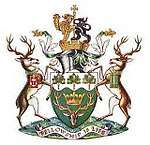 Coat of arms  Council logo | |
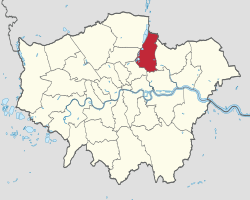 Waltham Forest shown within Greater London | |
| Sovereign state | United Kingdom |
| Constituent country | England |
| Region | London |
| Ceremonial county | Greater London |
| Created | 1 April 1965 |
| Admin HQ | Walthamstow |
| Government | |
| • Type | London borough council |
| • Body | Waltham Forest London Borough Council |
| • Leadership | Leader (Clare Coghill) & Cabinet (Labour) |
| • Mayor | Cllr Christopher Robbins[1] |
| • London Assembly | Jennette Arnold (Labour) AM for North East |
| • MPs | John Cryer (Labour) Stella Creasy (Labour) Iain Duncan Smith (Con) |
| Area | |
| • Total | 14.99 sq mi (38.82 km2) |
| Area rank | 286th (of 317) |
| Population (mid-2019 est.) | |
| • Total | 276,983 |
| • Rank | 54th (of 317) |
| • Density | 18,000/sq mi (7,100/km2) |
| • Ethnicity[2] | 36% White British 1.5% White Irish 0.1% White Gypsy or Irish Traveller 14.5% Other White 1.8% White & Black Caribbean 0.9% White & Black African 1% White & Asian 1.6% Other Mixed 3.5% Indian 10.2% Pakistani 1.8% Bangladeshi 1% Chinese 4.5% Other Asian 7.3% Black African 7.3% Black Caribbean 2.8% Other Black 1.5% Arab 2.6% Other |
| Time zone | UTC (GMT) |
| • Summer (DST) | UTC+1 (BST) |
| Postcodes | |
| Area code(s) | 020 |
| ONS code | 00BH |
| GSS code | E09000031 |
| Police | Metropolitan Police |
| Website | http://www.walthamforest.gov.uk/ |
The borough was formed in 1965 from the merger of the municipal boroughs of Leyton, Walthamstow and Chingford; it took its name from Waltham Forest – an institution which managed deer in south-west Essex.
Epping Forest is a remainder of the former Waltham Forest and forms the eastern and northern fringe of the borough. The River Lea lies to the west where its associated marshes and parkland form a green corridor which, along the reservoir-lined reaches, separates north and east London.
The north and south of the borough, split by the North Circular Road, contrast markedly in terms of demographic and socio-economic indicators; with urban districts in the south having inner-city characteristics, and the more affluent suburban areas to the north having better access to open spaces, parks, and playing fields. Chingford in the north, Walthamstow in the middle, and Leyton in the south are the three major districts of the borough.
Waltham Forest was one of the host boroughs of the London Olympics in 2012, with the Lee Valley Hockey and Tennis Centre and part of the Queen Elizabeth Olympic Park providing an ongoing legacy in the UK and London.
History
Early History
The area was in the territory of the Trinovantes tribe during the Iron Age and through the Roman period, when the tribal area was a unit of local government. It subsequently became part of the Kingdom of the East Saxons a unit which is likely to have its roots in the territory of the Trinovantes.[4] After the Kingdom of Essex lost its independence, it evolved into the county of Essex.
The Domesday book of 1086 records four manors in the area, Chingford, Walthamstow, Higham and Leyton. At some point, before or after the Domesday survey these also became parishes, with Higham becoming part of the parish of Walthamstow. These parishes had largely stable borders from which those of the later Municipal Boroughs were derived, and these are the basis of our understanding of the extent of these local areas today.
Preservation of Epping Forest
The southern part of Epping Forest still extends into the south of the borough, 90% of it having been preserved by the Epping Forest Act of 1878. This not only assisted in preserving the forest, the attraction value also helped stimulate urbanisation of nearby areas.
Urbanisation
Until the late Victorian era, the area that became the modern borough was rural in nature with a small dispersed population and a primarily agricultural landscape. Leyton, in particular, grew quite rapidly between 1870 and 1910.[5]
Industrial Firsts
In 1892, a private citizen named Frederick Bremer built the first British motorcar in a workshop in his garden, at Connaught Road, Walthamstow. The vehicle is on display at the Vestry House Museum in Walthamstow.[6] In 1909, the aviation pioneer A V Roe successfully tested the first all-British aeroplane, the Roe I Triplane, on land at Walthamstow Marshes.[7]
Air Raids in World War One
The area now known as Waltham Forest experienced at least two Zeppelin raids during World War I. On 17/18 August 1915, Airship L10 took a route roughly following the Gospel Oak to Barking railway line, dropping incendiary and high-explosive bombs. The first bomb, an incendiary, fell on Hoe St, Walthamstow, at the junction of Orford and Queens Road; the last was dropped in Aldersbrook area. Ten people were killed in Leyton and another 48 injured across the wider area. On 23/24 September 1916 the German Navy airship L 31 dropped around ten bombs along the line of Lea Bridge Road, Leyton, killing eight there. On both occasions the Germans believed they were bombing the City, and it is thought they mistook the Lee Valley Reservoir Chain for the Thames.[8]
Blitz - World War Two
During the most intense period of the Blitz (October 1940 to June 1941), the area was hit[9] by around 728 high explosive bombs, 17 parachute mines and an unknown, but much greater number of small incendiary bombs. Subsequent raids were lighter and less frequent,[10] but 1944 saw a number of V-1 ‘flying bombs’ and V-2 long-range ballistic missiles hit the area, including a V-1 which landed on central Walthamstow killing 22[11][12] and a V-2 which landed on Chingford Road, Walthamstow killing 8.[13]
Creation of the modern Borough
The London Government Act 1963 established the borough in 1965 from the combined areas of the former Municipal Borough of Chingford, Municipal Borough of Leyton and Municipal Borough of Walthamstow, which all transferred to Greater London from the English county of Essex.
A petition opposed calling the new borough "Walthamstow", so perhaps for that reason the new borough took its name from the former Waltham Forest, an institution responsible for managing deer in an area that stretched eastwards from the River Lea and included large areas of agricultural land as well as the wooded areas subsequently known as Epping Forest and Hainault Forest.
Settlement
The main centres of population in the borough are Chingford in the north, Walthamstow in the centre (the administrative hub including the council offices) and Leyton and Leytonstone to the South. Waltham Forest has the fifth largest Muslim population in England and the third largest in London (coming after its neighbouring boroughs, Newham and Tower Hamlets).
| Year | Pop. | ±% |
|---|---|---|
| 1801 | 6,500 | — |
| 1811 | 8,165 | +25.6% |
| 1821 | 9,239 | +13.2% |
| 1831 | 9,505 | +2.9% |
| 1841 | 9,806 | +3.2% |
| 1851 | 10,759 | +9.7% |
| 1861 | 22,635 | +110.4% |
| 1871 | 34,512 | +52.5% |
| 1881 | 46,388 | +34.4% |
| 1891 | 92,948 | +100.4% |
| 1901 | 154,146 | +65.8% |
| 1911 | 255,661 | +65.9% |
| 1921 | 267,592 | +4.7% |
| 1931 | 280,094 | +4.7% |
| 1941 | 274,172 | −2.1% |
| 1951 | 268,383 | −2.1% |
| 1961 | 251,205 | −6.4% |
| 1971 | 235,145 | −6.4% |
| 1981 | 214,595 | −8.7% |
| 1991 | 217,625 | +1.4% |
| 2001 | 218,277 | +0.3% |
| 2011 | 258,249 | +18.3% |
| Note:[14] | ||
Ethnicity
| Ethnic Group | 2001[15] | 2011[16] | ||
|---|---|---|---|---|
| Number | % | Number | % | |
| White: British | 121,694 | 55.7% | 92,999 | 36.0% |
| White: Irish | 5,112 | 2.4% | 3,959 | 1.5% |
| White: Gypsy or Irish Traveller | 369 | <1% | ||
| White: Other | 13,997 | 6.4% | 37,472 | 14.5% |
| White: Total | 140,803 | 64.5% | 134,799 | 52.1% |
| Asian or Asian British: Indian | 7,671 | 3.5% | 9,134 | 3.5% |
| Asian or Asian British: Pakistani | 17,295 | 7.9% | 26,347 | 10.2% |
| Asian or Asian British: Bangladeshi | 2,166 | <1% | 4,632 | 1.7% |
| Asian or Asian British: Chinese | 1,443 | <1% | 2,579 | <1% |
| Asian or Asian British: Other Asian | 5,084 | 2.3% | 11,697 | 4.5% |
| Asian or Asian British: Total | 33,659 | 15.4% | 54,389 | 20.8% |
| Black or Black British: African | 12,630 | 5.8% | 18,815 | 7.3% |
| Black or Black British: Caribbean | 17,797 | 8.2% | 18,841 | 7.3% |
| Black or Black British: Other Black | 3,246 | 1.5% | 7,135 | 2.7% |
| Black or Black British: Total | 33,673 | 15.4% | 44,791 | 17.3% |
| Mixed: White and Black Caribbean | 3,007 | 1.4% | 4,568 | 1.7% |
| Mixed: White and Black African | 1,195 | <1% | 2,403 | <1% |
| Mixed: White and Asian | 1,580 | <1% | 2,602 | 1.0% |
| Mixed: Other Mixed | 1,967 | <1% | 4,193 | 1.6% |
| Mixed: Total | 7,749 | 3.6% | 13,776 | 5.2% |
| Other: Arab | 3,776 | 1.4% | ||
| Other: Any other ethnic group | 2,457 | 1.1% | 6,728 | 2.6% |
| Other: Total | 2,457 | 1.1% | 10,504 | 4.0% |
| Black, Asian, and minority ethnic: Total | 77,538 | 35.5% | 123,450 | 47.9% |
| Total | 218,341 | 100.00% | 258,249 | 100.00% |
Open Spaces
Epping Forest and the green corridor along the River Lea provide some of the borough's many open spaces, which include:
- Epping Forest (part)
- Queen Elizabeth Olympic Park (part)
- Lee Valley Reservoir Chain (part)
- Walthamstow Marshes
- The Walthamstow Wetlands Reserve, opened in 2017, provides 211 ha (520 acres; 2.11 km2) of open space.
- Leyton Jubilee Park
- Lloyd Park
- Ridgeway Park
- Chingford Mount Cemetery
- Mansfield Park
- Highams Park Field
Arts, culture and leisure
Historically known as the seat of the Arts and Crafts Movement under the stewardship of William Morris, Waltham Forest has continued to succour many contemporary artists & art groups. These include the North East London Independent Artists (NELIA) group, based at the Changing Room Gallery in Lloyd Park, the 491 Gallery in Leytonstone, and a number of independent artists, also mainly in the Leytonstone area. The annual E17 Art Trail, which includes open studios, exhibitions and events, is the biggest art event in the borough, and there is now a similar event in Leytonstone. Eamon Everall, founder member of the Stuckism art movement is a long-time resident in the borough where he also maintains a studio.[17]
Waltham Forest is home to a number of musicians that have found success in the UK, including East 17, Blazin' Squad, and Indie band Hefner, who formed in Walthamstow. The borough is also a centre of the grime musical genre; grime acts hailing from the borough include More Fire Crew, Lethal Bizzle, and Jammer amongst others.
The only theatre in the borough, The Waltham Forest Theatre, was situated in Lloyd Park. Though a local campaign was launched to save it in 2008 [18] the theatre was demolished in 2011.
Leyton Orient F.C. is the local professional football team, based at Brisbane Road, Leyton. In the 1962–63 season the club played in the top tier of English football, the Football League First Division, but currently are in League Two, the fourth tier of the English football league system.
Truman's Brewery is moving to Waltham Forest close to Blackhorse Road underground station in 2020, which will be a new entertainment hub in Walthamstow.[19]
Waltham Forest is the first ever London Borough of Culture. The award from the Mayor of London ensures that arts and culture are placed at the heart of our communities. Some of the programmes are: Hennography, Polish Jazz London Series, Human Library, E17: My Home, Waltham Forest Cello Fest - "London Borough of Culture meets Classical Music", We're all bats, E17 Designers Winter Night Market, Underground Lunchtime Recitals, Forest Uprising, Welcome to the Forest and Fighter Workshops.[20]
Housing
Waltham Forest was one of six local authorities to set up a Housing Action Trust under the Housing Act 1988. The Waltham Forest HAT covered various estates in need of regeneration: Cathall Road in Leytonstone, Oliver Close in Leyton, Boundary Road in Walthamstow and Chingford Hall in Chingford. The HAT transferred its redeveloped estates to Community-based Housing Association and shut down in April 2002. English Partnerships then demolished four empty tower blocks.[21]
The remaining Council housing in the borough is now managed by an arms-length management organisation, Waltham Forest Housing (formerly Ascham Homes).[22]
Olympics
Waltham Forest was one of four host boroughs in east London for the 2012 Olympics. The northern part of the Queen Elizabeth Olympic Park is located in Eton Manor. The borough hosted events in its three Olympic-size swimming pools, one synchronised swimming pool and one water polo pool. These pools were used for athlete training.
During the Paralympic Games, Eton Manor hosted the Wheelchair Tennis events, with temporary seating for 10,500 spectators.
In April 2012, the Ministry of Defence identified the roof of Fred Wigg Tower as a potential location for surface-to-air missile defences during the Games.[23]
Education
Waltham Forest has a number of institutes, including 3 colleges of further education. Leyton Sixth Form College was the second sixth form college in Southern England to get a licence,[24] and was awarded the title of best college in London for sport in 2013.[25] Others include Waltham Forest College and Sir George Monoux College.
Neighbouring Boroughs and Constituent Districts
Neighbours
Neighbouring authorities are Epping Forest\Essex in the north, Redbridge in the east, with Newham and Hackney to the south. Haringey and Enfield lie to the west.
Districts of Waltham Forest
Wards
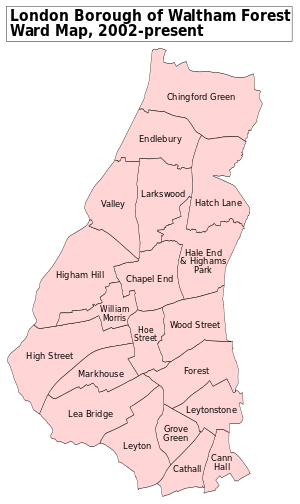
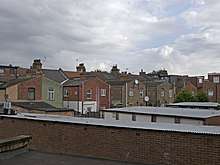
- Cann Hall
- Cathall
- Chapel End
- Chingford Green
- Endlebury
- Forest
- Grove Green
- Hale End and Highams Park
- Hatch Lane
- High Street
- Higham Hill
- Hoe Street
- Larkswood
- Lea Bridge
- Leyton
- Leytonstone
- Markhouse
- William Morris
- Wood Street
- Valley
Transport
The Central line of the London Underground serves the south of the borough, running alongside the A12 road with stations at Leyton and Leytonstone. The Victoria Line runs roughly through the middle of the borough with stations at Walthamstow Central and Blackhorse Road. The Gospel Oak to Barking Line of London Overground has stations at Walthamstow Queens Road, Blackhorse Road, Leyton Midland Road and Leytonstone High Road. London Overground also runs services from Liverpool Street station in the City of London and serves stations at St James Street, Walthamstow Central, Wood Street, Highams Park and Chingford. The pioneering Mini Holland program has begun to provide protected cycle lanes across the southern half of the borough[26], increasing the ability to use bicycles as a transport option.
In March 2011, the main forms of transport that residents used to travel to work were: underground, metro, light rail, tram, 21.0% of all residents aged 16–74; driving a car or van, 7.0%; bus, minibus or coach, 7.0%; train, 6.5%; on foot, 4.3%; work mainly at or from home, 2.1%; bicycle, 1.8%.[27]
Law enforcement
There is one police station which is based in Chingford and a number of additional patrol centres throughout the borough. Policing is now provided by the North-East Basic Command Unit (BCU) following a merger of Waltham Forest's and Newham's policing in 2018[28]
Notable residents

Waltham Forest is the birthplace of William Morris, best known as one of the principal founders of the British Arts and Crafts Movement. Morris was a designer of wallpaper and patterned fabrics, a writer of poetry and fiction, and a pioneer of the socialist movement in Britain.
Other notable people, such as footballer and former England Captain David Beckham, rapper, songwriter and actor Redzz, I, Claudius star Derek Jacobi, former Essex and England cricket Captain Graham Gooch, and the film director and producer Alfred Hitchcock, were also born in the borough. The heavy metal band Iron Maiden was formed in Leyton, and Eastenders actress Rita Simons was born in Leytonstone. Notable Eastenders Actor Adam Woodyatt is from Walthamstow. The poet Pascale Petit, shortlisted three times for the TS Eliot poetry prize, lives in Walthamstow. Notable rap/grime artist Lethal Bizzle is from Walthamstow, and Grayson Perry, the 2003 Turner Prize-winning artist, has his studio in Walthamstow. X Factor finalist Fleur East is also from Walthamstow as well as British Taekwondo Athlete Lutalo Muhammad.
Sports teams
Twinned cities
The London Borough of Waltham Forest is twinned[29] with


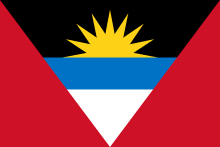

Friendship links have also been established with
Gallery
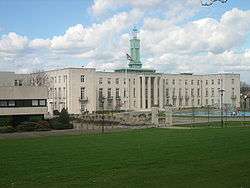 Walthamstow Town Hall
Walthamstow Town Hall- Queen Elizabeth's Hunting Lodge
- Walthamstow Stadium
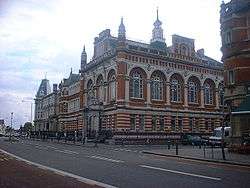 Leyton Town Hall
Leyton Town Hall- Walthamstow Marshes
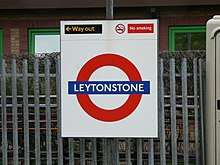 Leytonstone Station
Leytonstone Station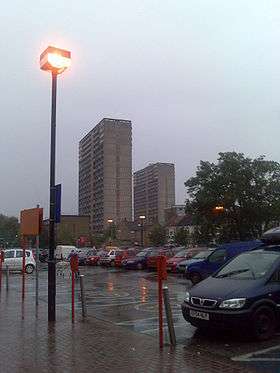 All Saints and St Paul's Tower
All Saints and St Paul's Tower
See also
- Waltham Forest parks and open spaces
- Waltham Forest Guardian
- Whipps Cross Hospital
References
- "The Mayor". London Borough of Waltham Forest. Retrieved 27 June 2018.
- 2011 Census: Ethnic group, local authorities in England and Wales, Office for National Statistics (2012). See Classification of ethnicity in the United Kingdom for the full descriptions used in the 2011 Census.
- "Waltham Forest definition and meaning | Collins English Dictionary". www.collinsdictionary.com. Retrieved 18 April 2018.
- Kings and Kingdoms of Early Anglo-Saxon England, p46. Barbara Yorke. Yorke makes reference to research by Rodwell and Rodwell (1986) and Bassett (1989)
- Powell, W R (1973). "'Leyton: Introduction', in A History of the County of Essex". London: British History Online. pp. 174–184. Retrieved 11 May 2020.
- "Bremer". Britainbycar.co.uk. 14 April 2015. Retrieved 11 May 2020.
- "Alliott Verdon Roe - E17 (1) : London Remembers, Aiming to capture all memorials in London". Londonremembers.com. Retrieved 11 May 2020.
- London 1914-17 The Zeppelin Menace, Ian Castle. Osprey Publishing 2008
- University of Portsmouth, in collaboration with the National Archives and funded by JISC. "Bombs dropped in Waltham Forest - Bomb Sight - Mapping the World War 2 London Blitz Bomb Census". Bomb Sight. Retrieved 11 May 2020.
- "Bomb Census London: An East End Raid Over Walthamstow And Leyton". Culture24. Retrieved 11 May 2020.
- "London V2 Rocket Sites...Mapped". Londonist. 2 August 2018. Retrieved 11 May 2020.
- "V1 Bomb Damage Walthamstow - British Pathé". Britishpathe.com. Retrieved 11 May 2020.
- "V2 Rocket incident at Chingford Road, Walthamstow. Remains of a Stock Photo: 81006133". Alamy. Retrieved 11 May 2020.
- "Waltham Forest: Total Population". A Vision of Britain Through Time. Great Britain Historical GIS Project. Retrieved 3 February 2020.
- "KS006 - Ethnic group". NOMIS. Retrieved 30 January 2016.
- "Ethnic Group by measures". NOMIS. Retrieved 8 January 2016.
- "'The Gift', Eamon Everall", Walker Art Gallery, National Museums Liverpool. Retrieved 16 October 2008.
- Sarah Cosgrove, "Teenage twins in bid to take over theatre", The Waltham Forest Guardian
- 'Hot Dinners News', Retrieved 24 May 2019.
- BBC: "Events mark Waltham Forest becoming Borough of Culture"
- "English Partnerships: A residuary body for Housing Action Trusts". Archived from the original on 5 January 2008. Retrieved 3 March 2007.CS1 maint: BOT: original-url status unknown (link)
- "Ascham Homes performance worsens". Waltham Forest Guardian. 24 May 2010. Archived from the original on 26 May 2010. Retrieved 1 May 2012.
- "Missiles could be deployed at six sites during Olympics, MOD confirm". Daily Telegraph. 1 May 2012. Retrieved 1 May 2012.
- Koscielak, Kasia. "News - Leyton Sixth Form achieves Investors in People Gold Award". www.londoncolleges.com. Archived from the original on 26 August 2014. Retrieved 27 September 2014.
- "College named best in London for sport". East London and West Essex Guardian Series.
- "About Enjoy Waltham Forest | Enjoy Waltham Forest". enjoywalthamforest.co.uk. Retrieved 14 July 2020.
- "2011 Census: QS701EW Method of travel to work, local authorities in England and Wales". Office for National Statistics. Retrieved 23 November 2013. Percentages are of all residents aged 16-74 including those not in employment. Respondents could only pick one mode, specified as the journey’s longest part by distance.
- "The Met to Merge Newham & Waltham Forest police forces".
- "Town twinning". Waltham Forest Council. Retrieved 7 November 2017.
External links
| Wikimedia Commons has media related to London Borough of Waltham Forest. |
